Vitamins
Question 1. Classify vitamins. Indicate dietary sources, daily requirements & deficiency of fat-soluble vitamins, Briefly explain the role of vitamin A In the vision (or) Give the sources, functions & deficiency symptoms of vitamin A. (or) Vitamin A deficiency.
Answer:
Vitamins:
Classification:
- Vitamins are classified into
Read And Learn More: BDS Previous Examination Question And Answers
- Fat Soluble Vitamins
- Vitamin A
- Vitamin D
- Vitamin E
- Vitamin k
- Water-soluble vitamins
- Vitamin B
- Energy releasing vitamins
- B1- Thiamine
- B2- Riboflavin
- B3- Niacin
- B6- Pyridoxine
- 7- Biotin
- Pantothenic acid
- Hemopoietic vitamins
- B12- Cyanocobalamin
- Folic acid
- Vitamin B
Fat Soluble Vitamins:
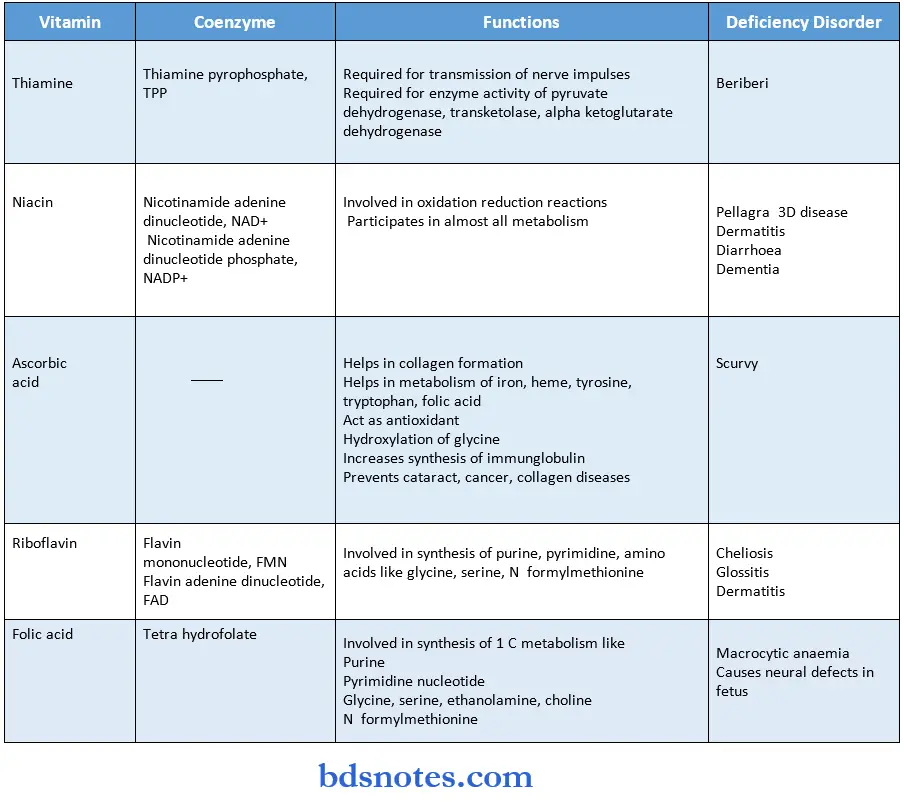
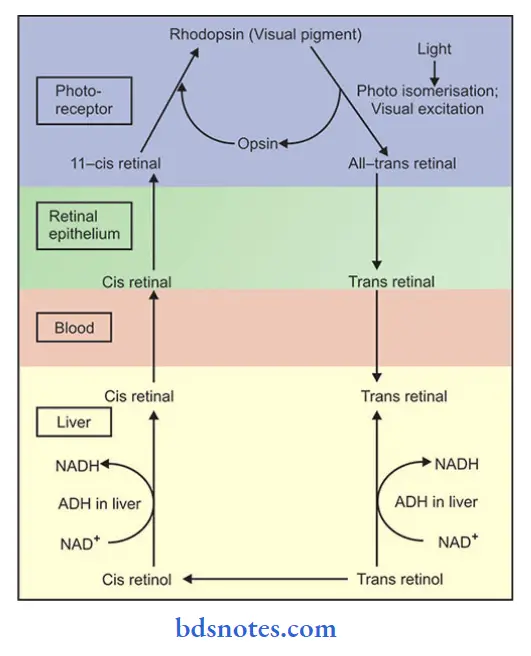
- Role of vitamin A in vision:
- Retinol and retinal k retinoic acid are forms of vitamin A
- Retinal takes part in a visual cycle called Rhodopsin Cycle or Wald’s visual cycle
- In this cycle, initially on exposure to light isomer/atum of 11 I is-retinal to aII Irate, retinal occurs
- All trans-retinal is immediately isomer/ed to 11 cis-retinal
- This combines with opsin k forms Rhodopsin
- Most of the all-trans-retinal is the transporter to liver
- It is converted to all trans-retinol by alcohol dehydrogenase
- All trans-retinol is isomerized to 11-cis-retinol
- This is oxidized to 11-cis-retinal by alcohol dehydrogenase
- Now this re-enters into the visual cycle
Question 2. Enumerate the functions of vitamin D. Explain its importance in calcium metabolism
Answer:
Functions of vitamin D:
- Calcitriol (1,25-dihydroxycholecalciferol) is the active form of vitamin D
- Its functions are as follows:
- Increases intestinal absorption of calcium & phosphate
- Essential for bone formation
- Minimizes excretion of calcium & phosphate
Importance in calcium metabolism:
In the intestine, Calcitriol binds with a systolic receptor & forms a Calcitriol-receptor complex.
↓
This enters the nucleus & interacts with DNA
↓
This induces the synthesis of calcium-binding protein
↓
This increases calcium absorption by the intestine
↓
This increases calcium level
- It also promotes calcification & remodeling of bone
- It increases the mobilization of calcium & phosphate from bone
Question 3. Describe the formation of the active form of vitamin D. Describe its biochemical functions, deficiency features & daily requirements.
Answer:
Formation of the active form of vitamin D:
- Calcitriol also called 1,25-dihydroxycholecalciferol is the active form of vitamin D
- Its synthesis requires Cytochrome, NADPH & molecular oxygen
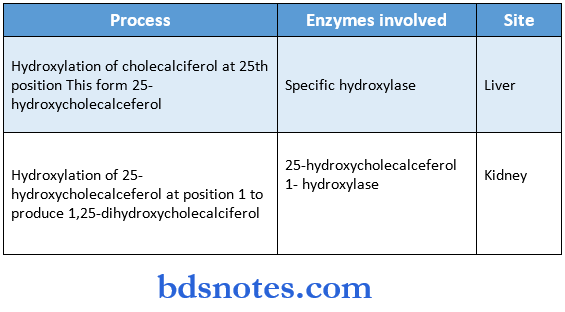
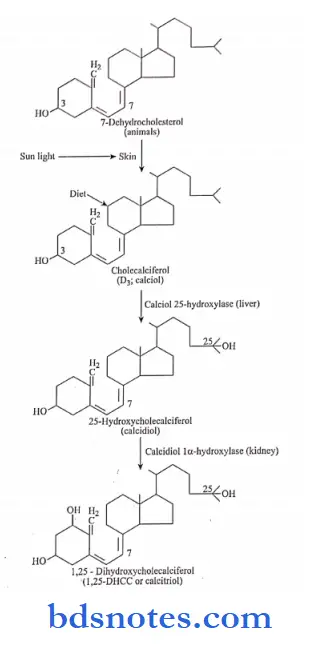
Deficiency:
- Vitamin D deficiency causes rickets in children & Osteomalacia in adults
- Features of it are as under:

Daily requirements:
- The daily requirement of vitamin D is 400 IU
Question 4. Give an account of the sources, metabolic functions, daily requirements & deficiency manifestation of vitamin C.
Answer:
Vitamin C:
Sources:
- Citrus fruits- Gooseberry, guava
- Green vegetables
- Tomatoes & Potatoes
Functions:
1. Role in collagen formation
- It acts as a coenzyme in the hydroxylation of proline & lysine
- These are required to convert procollagen to collagen
2. It is required for bone formation
3. Role in metabolism
- Iron metabolism
- It enhances iron absorption
- Helps in tire formation of ferritin
- Helps in the mobilization of iron from ferritin
- Hemoglobin metabolism
- It is used to reconvert methemoglobin to hemoglobin
- Required for degradation of hemoglobin to bile pigments
- Tryptophan metabolism
- Essential for hydroxylation of Trytophan to hydroxytryptophan
- Tyrosine metabolism
- Required for oxidation of p-hydroxy phenylpyruvate to homogentisate acid
- Polic acid metabolism
- Required for the formation of tetrahydrofolate, an active form of folic acid
4. Hormonal functions
- Peptides are derived from glycine
- Vitamin C is required for the hydroxylation of glycine
- It is required for the synthesis of steroids hormones
- It is a strong antioxidant
5. It enhances the synthesis of immunoglobulin
6. Preventive functions
7. It prevents the risk of
- Cataract
- Cancer
- Coronary heart diseases
Daily requirements:
- The daily requirement of vitamin C is 60-70 mg
Deficiency manifestations:
- A deficiency of vitamin C leads to scurvy
Features of scurvy:
- Spongy & sore gums
- Loose teeth n Anemia
- Swollen joints
- Fragile blood vessels
- Decreased immunocompetence
- Delayed wound healing
- Impaired hormonal functions of adrenal cortex & gonads B Hemorrhage
- Osteoporosis
Question 5. Name important vitamins which are required for the proper functioning of nerves. Describe the sources, requirements, biochemical functions & deficiency manifestation of any one (or) Explain the role of thiamine (or) Deficiency manifestation of thiamine.
Answer:
Vitamins required for neurological functions:
- Vitamins necessary for neurological functions are
- Thiamine, Vitamin B1
- Pyridoxine, Vitamin B6
Thiamine, vitamin B1:
Sources:
1. Plant sources
- Cereals, Pulses, oil seeds, nuts & yeast
2. Animal sources
- Pork, liver, heart, kidney, milk, etc
Requirements:
- The daily requirement of Thiamine is
- Adults-1-1.5 mg/day
- Children- 0.7-1.2 mg/ day
Functions:
- Thiamine pyrophosphatase, TPP, a Coenzyme of Thiamine is required in the transmission of nerve impulses.
- It is required for following enzyme activity
- Pyruvate dehydrogenase to convert pyruvate to acetyl CoA
- Alpha-ketoglutarate dehydrogenase
- Used in the TCA cycle
- Transketolase
- Utilized in hexose monophosphate shunt
- Branched-chain alpha-keto acid dehydrogenase
-
- Used to catalyze oxidative Decarboxylation of branched-chain amino acids
Deficiency manifestations:
A deficiency of Thiamine results in beri beri
Symptoms:
- Loss of appetite
- Weakness
- Constipation
- Nausea
- Mental depression
- Peripheral neuropathy
- Irritability
- Numbness in the legs
Types:
- Wet Beri Beri
- Characterized by edema of legs, face, trunk & sere us cavities
- Dry beri beri
- Associated with neurological manifestations
- Infantile Beri Beri
- Seen in infants
Question 6. Name the water-soluble vitamins, and describe any one of them.
Answer:
Water soluble vitamins:
1. Vitamin B:
- Energy releasing trains
- B1 – Thiamine
- B2 – Riboflavin
- B3 – Niacin
- B6 – Pyridoxinr
- B7 – Biotin
- Pantothenic acid
- Hemopoietic vitamins
- B12 – cyanocobalamin
- Folic acid
2. Vitamin C:
- Sources
- Citrus fruits
- Green vegetables
- Tomatoes and potatoes
- Functions
- Required to convert procollagen to collagen
- Required for bone formation
- Help in iron, hemoglobin, tryptophan, tyrosine, and folic acid metabolism
- Required for hydroxylation of glycine
- Required for synthesis of steroid hormones
- Act as a strong antioxidant
- Enhance the synthesis of immunoglobulin
Daily requirements – 60-70 mg:
Deficiency manifestation – scurvy:
- Spongy and sore gums
- Loose teeth
- Anaemia
- Swollen joints
- Fragile blood vessels
- Decreased immunocompetence
- Delayed wound healing
- The impaired hormonal function of the adrenal cortex and gonads
- Hemorrhage
- Osteoporosis
Question 7. Biological functions of Vitamin A
Answer:
- Retinol, retinal & retinoic acid are forms of vitamin A
- These forms perform various functions
- Role in vision
- Vitamin A is required for vision
- The retinal, form of vitamin A is linked to the amino group of lysine of opsin
- This forms Rhodopsin
- Rhodopsin is used in the visual cycle
- Hormonal functions
- Retinol & retinoic acid acts as steroid hormones
- These regulate protein synthesis
- They are involved in cellular growth & differentiation
- It maintains healthy epithelial tissue
- Synthetic functions
- Certain glycoproteins
- Retinol synthesizes retinyl phosphate
- This is required for glycoproteins synthesis
- Transferrin
- Retinol & retinoic acid are involved in its synthesis
- Cholesterol
- Vitamin A is required for its synthesis
- Synthetic functions
- Immunological functions
- Vitamin A maintains a proper immune system
- Antioxidant
- Carotenoids function as an antioxidant & reduce the risk of cancer
Question 8. Visual cycle
Answer:
Synonyms:
- Rhodopsin cycle or Wald’s visual cycle
Visual Cycle:
- In this cycle, initially on exposure to lip, high isomerization of 11 cis-retinal lo all Irans-regional occurs
- All Irans-retinal is immediately isomerized lo 11-cis-retinal
- This combines with opsin & forms Rhodopsin
- Most of all Irans-retinal is transported to liver
- It is converted to all Irans-retinol by alcohol dehydrogenase
- All trans-retinol is isomerized lo 1 l-cis-retinol
- This is oxidized lo 11-cis-retinal by alcohol dehydrogenase
- Now this re-enters into the visual cycle
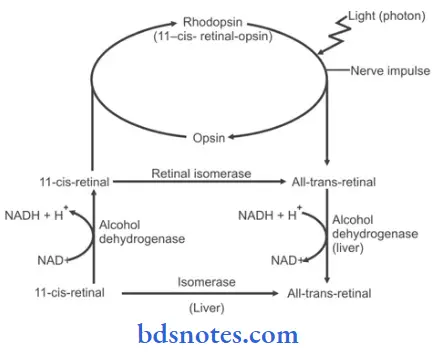
Question 9. How does vitamin K take part in the coagulation of blood?
Answer:
- Vitamin K causes post-translational
- It acts as a coenzyme for the carboxylation of glutamic acid residues present in proteins by the carboxylase enzyme
- This converts glutamate to gamma carboxyglutamate
- Gamma carboxyglutamate is negatively charged
- It combines with positively charged calcium ions to form a complex
- This complex binds to the phospholipids on the surface membrane of platelets
- This increases the conversion of prothrombin to thrombin
- This helps in blood clotting
Question 10. Vitamin K
Answer:
- It is a fat-soluble vitamin
Sources:
Vitamin K
- Animals sources
- Egg yolk, meat, liver, cheese & dairy products
- Plant sources
- Cabbage, cauliflower, tomatoes, alfa, spinach
Functions:
- It helps in blood coagulation
Daily requirements:
- 70-140 microgram/ day Deficiency symptoms:
- Diminished blood clotting
- Increased prothrombin time
Question 11. Coenzymes forms & deficiency of niacin
Answer:
Coenzymes forms of niacin:
- Nicotinamide adenine dinucleotide, NAD+
- Nicotinamide adenine dinucleotide phosphate, NADP+
Deficiency symptoms of niacin:
- A deficiency of niacin causes pellagra
- Its symptoms are referred to as 3Ds
- D- Dermatitis
- It is inflammation of the skin
- It is found in the areas of the skin that are exposed to sunlight
- D- Diarrhea
- It is in the form of loose stools
- Prolonged diarrhea leads to weight loss
- D- Dementia
- Associated with degeneration of nervous tissue
- It includes:
- Anxiety
- Irritability
- Poor memory
- Insomnia
Question 12. Niacin.
Answer:
- It is vitamin B3
- It is pyridine derivative Coenzymes forms of niacin:
- Nicotinamide adenine dinucleotide, NAD+
- Nicotinamide adenine dinucleotide phosphate, NADP+
Functions:
- Coenzymes of niacin are involved in oxidation-reduction reactions
- They participate in almost all the metabolism Deficiency symptoms of niacin:
- A deficiency of niacin causes pellagra
Question 13. Name Coenzymes of niacin, Riboflavin, Pyridoxine & thiamine
Answer:
Coenzymes of:
- Niacin
- Nicotinamide adenine dinucleotide, NAD+
- Nicotinamide adenine dinucleotide phosphate, NADP+
- Riboflavin
- Flavin mononucleotide, FMN
- Flavin adenine dinucleotide, FAD
- Pyridoxine
- Pyridoxal phosphate, PLP
- Thiamine
- Thiamine pyrophosphate, TPP
Question 14. Biological functions of pyridoxine
Answer:
- The Coenzyme of Pyridoxine, Pyridoxal phosphate, PLP, is attached to the delta amino group of lysine
- It participates in reactions like
- Transamination
- It converts amino acids to keto acids – These keto acids enter the TCA cycle & generates energy
- PLP interacts with amino acids to form Schiff base
- Decarboxylation
- Many amines are synthesized by PLP Decarboxylation
- They are:
- Serotonin
- Histamine
- Gamma amino butyric acid
- Catecholamines
- Deamination
- The Hydroxyl group-containing amino acids require PLP
- Transsulfuration
- It involves the transfer of sulfur from homocysteine to serine
- It requires PLP-dependent cystathionine synthase
- Transamination
- Synthetic functions
- Synthesis of niacin Coenzymes from tryptophan
- Synthesis of serine from glycine
- Glycogen phosphorylase contains PLP
- It is needed for the intestinal absorption of amino acids
- 6. It prevents urinary stone formation
Question 15. Vitamin B12.
Answer:
It is cyanocobalamine
Coenzyme forms:
- 5′- Deoxyadenosyl cobalamin
- Methylcobalamin
Functions:
- Synthesis of methionine from homocysteine
- Vitamin B12 is used as Methylcobalamin in this reaction
- Isomerization of methylmalonic CoA to succinyl CoA
- It occurs in the presence of vitamin B12 Coenzyme, deoxyadenosine cobalamin
Dietary requirements:
- Adults- 3 micrograms/ day
- Children-0.5-1.5 microgram/day
- During pregnancy & lactation- 4 micrograms/ day
Deficiency symptoms:
- A deficiency of vitamin B12 leads to
- Pernicious anemia
- characterized by low hemoglobin levels, decreased number of erythrocytes & neurological manifestations
- Neuronal degeneration
- Demyelination of the nervous system
Question 16. Riboflavin deficiency
Answer:
- Riboflavin deficiency symptoms include
- Cheilosis
- Presence of fissures at the comer of the mouth
- Glossitis
- Tongue appears smooth & purplish
- Dermatitis
- Cheilosis
Question 17. Synthesis of thyroxine
Answer:
- Thyroxine is a thyroid hormone
- It is synthesized from the tyrosine residues of the protein thyroglobulin & activated iodine
- The tyrosine of thyroglobulin is first iodinated at position 3 to form monoiodotyrosine
- Next, it is iodinated at position 5 to form diiodotyrosine
- Later two molecules of diiodotyrosine couple to form thyroxine T4
- As the process of iodination is completed, each molecule of thyroglobulin contains about 6-8 molecules of thyroxine
Question 18. Mechanism of action of vit D
Answer:
1. Action on the intestine
In intestinal cells, calcitriol binds with cytosolic receptors
↓
Forms calcitriol – receptor complex
↓
Complex enters the nucleus of the cell
↓
Interacts with DNA
↓
This leads to the synthesis of calcium-binding protein
↓
This protein increases calcium uptake by the intestine
2. Action on bones
- Increases calcium deposition in osteoblasts
3. Action on kidneys
- Minimizes excretion of calcium and phosphorous
Question 19. Give an account of the chemistry, sources, and dietary functions of folic acid.
Answer:
Folic acid:
Chemistry
- Consists of
- Pteridine ring
- p-amino benzoic ring (PABA)
- Glutamic acid
- Has one glutamic acid residue known as pleural-glutamic acid
- The active form is tetrahydrofolate
- Dihydrofolate reductase → folic acid → tetrahydrofolate
- H+ atoms are present at position 5,6,7 & 8 of tetrahydrofolate
Sources
- Found in abundant in leafy vegetables
Dietary functions
- Involved in the synthesis of 1 C metabolism like
- Purine
- Pyrimidine nucleotide
- Glycine, serine, ethanolamine, choline
- N – formylmethionine
Question 20. Write coenzyme form, one function, and one deficiency disorder of the following
- Thiamine
- Niacin
- Ascorbic acid
- Folic acid
- Riboflavin
Answer:
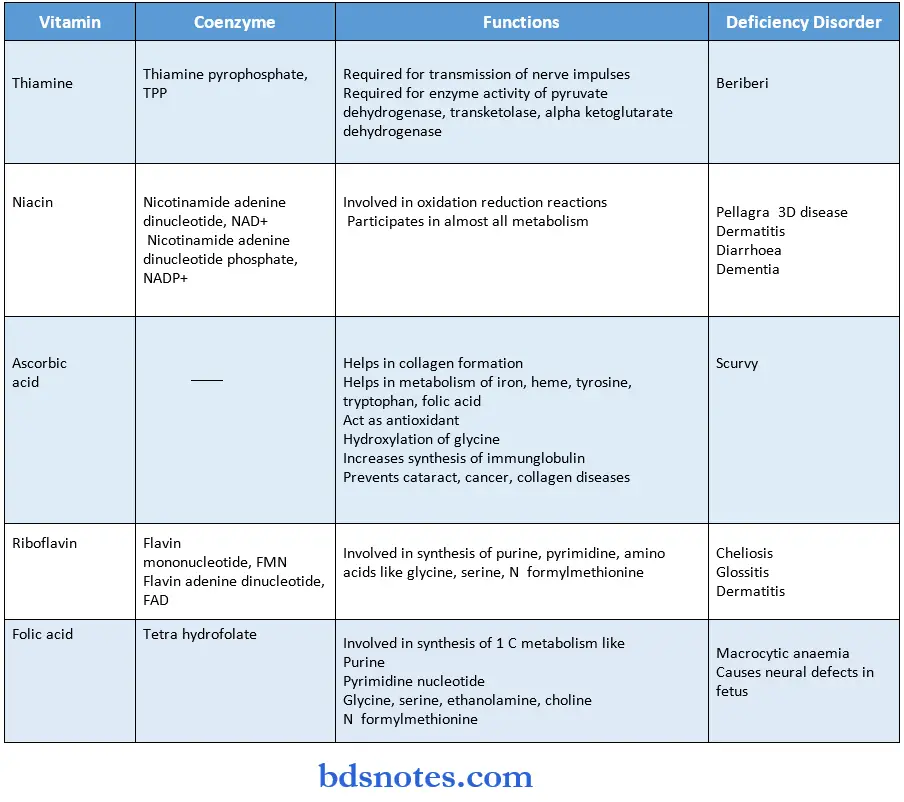
Question 21. Describe the functions of thiamine
Answer:
Functions of Thiamine:
- Thiamine pyrophosphatase, TPP, a Coenzyme of Thiamine is required in the transmission of nerve impulse
- It is required for following enzyme activity
- Pyruvate dehydrogenase to convert pyruvate to acetyl CoA
- Alpha-ketoglutarate dehydrogenase
- Used in the TCA cycle
- Transketolase
- Utilized in hexose monophosphate shunt
- Branches chain alpha-keto acid dehydrogenase
- Used to catalyze the oxidative decarboxylation of branched-chain amino acids
Question 22. Fat-soluble vitamins
Answer:
Vitamins A, D, E & K are fat-soluble vitamins
Properties:
- Their availability in diet, absorption & transport is associated with fat
- They are soluble in fats & oils & in fat solvents
- They are stored in the liver & adipose tissues
- They are not readily excreted in urine
- They are isoprenoid compounds
- They have a variety of functions
Question 23. List four features of vitamin A deficiency
Answer:
- Features of vitamin A deficiency are
- Night blindness
- Xerophthalmia
- Keratomalacia
- Retarded growth
Question 24. Vitamin D
Answer:
- It is a fat-soluble vitamin
- It resembles sterols in structure
- Its best source is sunlight
- Its active form is calcitriol
- It is involved in calcium metabolism
- Required in bone formation
- Its daily requirement is 400IU
- Its deficiency leads to rickets in children & osteomalacia in adults
Question 25. Pellagra
Answer:
- A deficiency of niacin causes pellagra
- It is referred to as 3D disease
- D- Dermatitis
- It is inflammation of the skin
- It is found in the areas of the skin that are exposed to sunlight
- D- Diarrhea
- It is in the form of loose stools
- Prolonged diarrhea leads to weight loss
- D- Dementia
- Associated with degeneration of nervous tissue
- It includes:
- Anxiety
- Irritability
- Poor memory
- Insomnia
Question 26. Vitamin C
Answer:
- It is water soluble vitamin
- It plays an important role in human health & disease
- It is readily absorbed by the intestines & excreted in urine
- About 60-70 mg of vitamin C is required per day
- Citrus fruits are main sources of vitamin C
- Its deficiency leads to scurvy
Question 27. Coenzymes of Riboflavin & niacin
Answer:
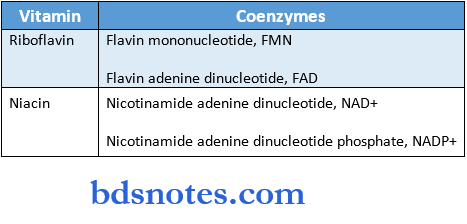
Question 28. What are the diseases caused by deficiency of Niacin & Vitamin B12
Answer:
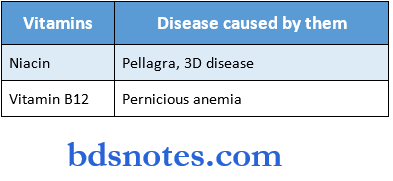
Question 29. Importance of folic acid in the diet
Answer:
- Folic acid is important in one-carbon metabolism
- The Coenzyme of it, tetrahydrofolate( THF), serves as an acceptor or donor of one carbon units
- It is involved in the synthesis of important compounds like
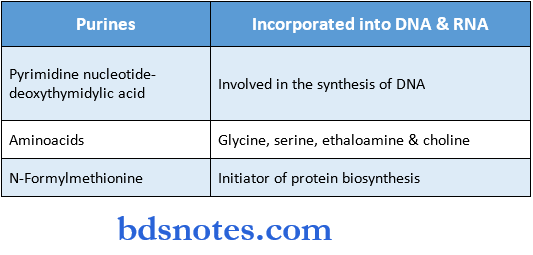
Question 30. Source & functions of vitamin B12
Answer:
Sources:
- Liver, kidney, milk, curd, eggs, fish, pork & chicken
Functions:
- Synthesis of methionine from homocysteine
- Vitamin B12 is used as Methylcobalamin in this reaction
- Isomerization of methylmalonic CoA to succinyl CoA
- It occurs in the presence of vitamin B12 Coenzyme, deoxyadenosine cobalamin
Question 31. Name the vitamins necessary for neurological functions
Answer:
- Vitamins necessary for neurological fun lions are
- Thiamine, Vitamin HI
- Pyridoxine, Vitamin H6
Question 32. Name the Coenzymes of vitamin Bl, B6
Answer:
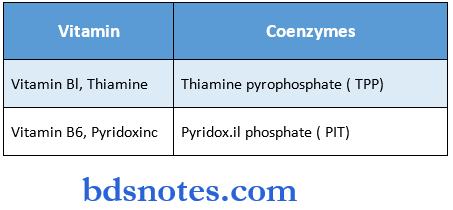
Question 33. Name hemopoietic vitamins
Answer:
- Hemopoietic vitamins are
- Folic acid
- Vitamin B12
Question 34. Functions of cyanocobalamine
Answer:
- Synthesis of methionine from homocysteine
- Cyanocobalamine is used as methylcobalamin in this reaction\
- Isomerization of methylmalonic CoA to succinyl Co A
- It occurs in the presence of the coenzyme deovyadenosyl cobiaum
Question 35. Ascorbic acid deficiency / Scurvy
Answer:
- A deficiency of ascorbic acid leads to scurvy
Features:
- Spongy and sore gums Loose teeth
- Anaemia
- Swollen joints
- Fragile blood vessels
- Decreased immunocompetence
- Delayed wound healing
- Impaired hormonal functions of adrenal cortex and gonads
- Hemorrhage
- Osteoporosis
Question 36. Provitamins
Answer: It is a substance that may be converted within the body into a vitamin
It is a substance with little or no vitamin activity but can be converted to an active form by normal metabolic processes
Example:
- Provitamin B5 is panthenol which may be converted in the body to vitamin B5
- Provitamin A is (3 carotenes, the body uses an enzyme to convert it to retinol
Question 37. Name the vitamin which has antioxidant properties.
Answer:
Vitamins having antioxidant properties are:
- Vitamin E
- Vitamin C
Question 38. What are the different types and features of beriberi?
Answer:
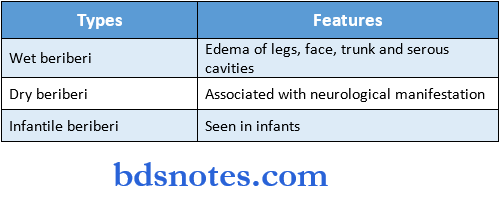
Question 39. Name a vitamin that acts as an antioxidant (or) Name a vitamin that acts as a steroid hormone
Answer:
- Vitamin as an antioxidant – vitamin E and vitamin C
- Vitamin as steroid hormone – vitamin D
Question 40. Rickets
Answer:
- Vitamin D deficiency causes Rickets in children
- Features:
- Bone deformities
- Incomplete bone mineralization
- Bones become soft
- Teeth formation is delayed
- Bowed legs
- Decreased plasma level of calcitriol
- Elevated alkaline phosphatase activity

Leave a Reply